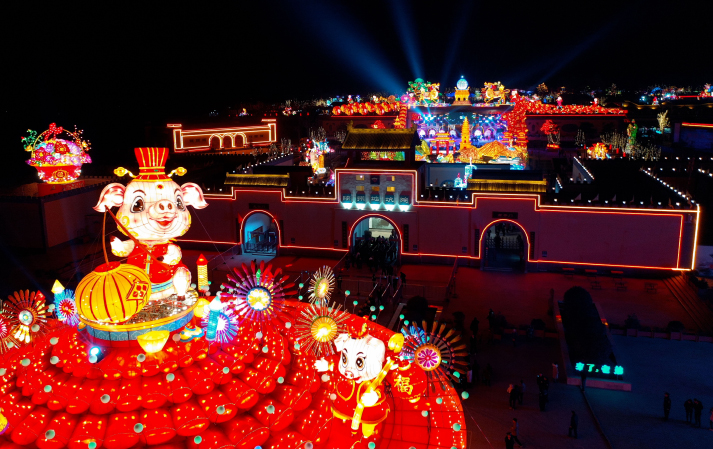| China |
| Piggybacking on the Spring Festival | |
|
|
 A lantern show is held to celebrate the Year of the Pig in Shanzhou, central China's Henan Province (XINHUA)
The start of the Lunar New Year, or the Spring Festival, on February 5 this year, marked the world's largest annual human migration. In Beijing, days before the actual festival, many Chinese either leave or arrive in the capital to celebrate with family. However, weeks before this year's festival, the Chinese and I started to get into the spirit of the Year of the Pig, which is the last of the 12 animals of the Chinese zodiac in a 12-year cycle. Shops were selling duilian (couplets written vertically and hung down the sides of a doorway) and decorations featuring pigs. Goods with a pig motif popped up in shops, on the streets and subways, and my Chinese boyfriend was even gifted a glittery golden stuffed pig with the Chinese character fu (blessing) on it. Parks were decorated for the temple fairs, along with houses and office buildings. Red lanterns festooned doorways. To me, the Spring Festival is a lot like Christmas and Thanksgiving combined—it's about family reunions, sharing meals and creating warmth in the cold of winter. In the office, we will be working with a skeleton crew as most of my Chinese coworkers will have left for home. Every year, there is a Spring Festival reception for the foreign employees and a buffet dinner in the canteen of my workplace for those who are still in Beijing. The nice thing about the buffet is its egalitarian nature. Everyone is included, not only the foreign and Chinese employees, but the cleaning staff as well. Many shops and restaurants are closed during the Spring Festival week, with China at a standstill for about a week, causing some folks to not feel too merry. A U.S. friend of mine had a Grinch-like attitude toward the Spring Festival since it delayed work on his startup company. "Hate holiday time… slow down not fun," he grumbled in a WeChat message. My attitude toward the festival has also soured on occasion when some of my late-night commutes home from work have been fraught with immense difficulty. The worst was the Spring Festival Eve three years ago when I was working a night shift. Getting a taxi that night was a nightmare—almost all of Beijing's taxi drivers were enjoying the festival at home with their families and couldn't even be lured into taking passengers with a surcharge when you called the cab companies or used an app. A coworker finally took me home, otherwise I would have most likely spent China's most important night of the year in the office. On the positive side, I have now developed a strong enthusiasm for Beijing's miaohui, or temple fairs, and squeeze in as many as I can into my days off during the Spring Festival period. The ones at Ditan Park, Grand View Garden and Longtan Park are my favorites. At Ditan, there are various goods for sale, mainly arts and crafts, and snacks. There I participated in printmaking with a carved printing block, producing an orange print of Sun Wukong, the Monkey King. When I told one of my Chinese coworkers I had visited Ditan, she was delighted and remembered how much fun she used to have there as a child. The temple fair at Grand View Garden features a pageant centered on the classic Chinese novel, The Dream of the Red Chamber (the park was used for the filming of the eponymous TV series back in the 1980s). One year, I had my photo taken with some of the actors portraying Baoyu, the playboy of the Jia family, along with Granny Jia. My boyfriend spotted Chairman Mao Zedong's grandson visiting a souvenir shop selling kites, but he left in a hurry before we could get closer. At the Longtan Park temple fair, you can play Chinese or Western chess with other fair visitors. I once ended up playing chess with a high school student for about an hour. The student's father said a Chinese chess grandmaster was present. In addition, Longtan Park temple fair has exceptionally beautiful handicrafts, for example clay animals, carved gourds and slippers topped with tiger heads for children. The Spring Festival spirit is contagious, and every year, I find myself catching it. The nice thing about being immersed in a totally different culture as a foreigner is that you can piggyback and revel in local festivals as well. The author is an American living in Beijing Copyedited by Rebeca Toledo Comments to dingying@bjreview.com
|
|
||||||||||||||||||||||||||||
|
